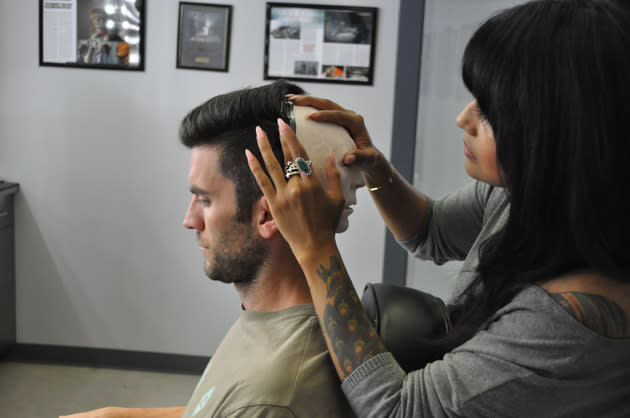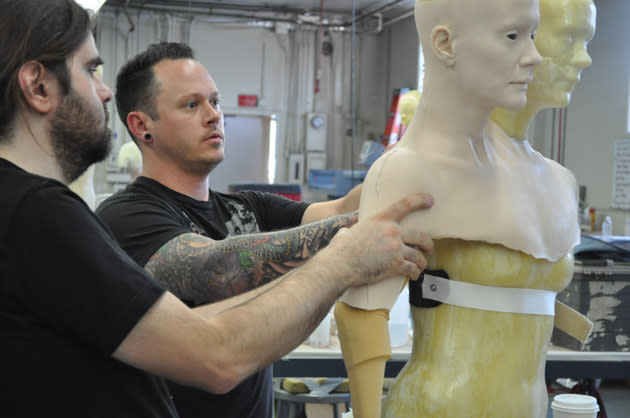The Emmy-winning studios behind American Horror Story's freaks

The body in the brown box looks cold at first glance. The blue-green web of veins in her pale white legs can be traced down to her feet. Her flaming red hair looks like it hasn't been brushed for weeks and her torso is split wide open. Justin Raleigh reaches in and plucks out her intestines and liver. He knows her anatomy all too well. It's been built from scratch for an upcoming TV series in his workshop in Monrovia, California.
Raleigh's been in the business of creating the perfect Hollywood scare for the last two decades. At Fractured FX, his special makeup effects workshop, he works with a small crew to create creatures that don't exist, prosthetics that transform the human form and bodies that duplicate an actor's anatomy with uncanny precision. From Insidious and 300: Rise of an Empire to The Knick and Boardwalk Empire, the makeup and prosthetics designer's work in both films and episodic television has created effects that are unsettling yet enthralling.

The impact of his work peaked in Freak Show, the fourth season of Ryan Murphy and Brad Falchuk's FX drama American Horror Story. The sideshow characters in the most recent chapter of this anthology of blood, gore and terror weren't easy to watch, but they were hard to look away from. They captured the emotional and physical complexities of people with medical oddities. "Most of them were based on a real character," says Raleigh, who recently won a Creative Arts Emmy for his work on the show. "A lot of it came from real abnormalities and references -- from the Mütter Museum [a medical museum in Philadelphia], various carnival freak show books and references in the market. For the most part, we pull from reality and augment it with a little bit of fantasy."
Raleigh's studio has the tools to build robotic heads and armatures, but he mostly relies on the power of physical effects. Before turning to computer-generated imagery for augmentation, he molds life casts and builds prosthetics. For American Horror Story, he sculpted the deformities that helped define the characters. He made a foam rubber piece to give Lobster Boy, one of the central characters played by Evan Peters, his claw-like extremities. He created a small parasitic twin that was static on the back of actor Wes Bentley's head so he could pull off the role of Edward Mordrake, a character based on a 19th century man with the same name who had two faces, front and back. The head was later augmented with visual effects.

Wes Bentley, who plays Edward Mordrake on American Horror Story, receives a parasitic twin.
The highlight of the show, however, was the conjoined-twin sisters Dot and Bette Tattler. For the two-in-one character played by Sarah Paulson, a recurring name in American Horror Story's stellar ensemble, Raleigh's studio created two animatronic heads, one for each identical twin with a distinct personality. With a silicone impression of Paulson as a basis, the team duplicated her features to build the radio-controlled heads that had moving mouths and eyes that could blink and look around.
While the close-up shots of the Tattler sisters were essentially created with split-screen visual effects, for any of the wider and overhead shots, Paulson worked with Raleigh's makeshift heads. His team made a custom, lightweight carbon fiber structure that was harnessed across Paulson's waist to support the weight of the additional head on her shoulders. After completing her performance as one dominant character, she would swap the robotic prosthetic and switch roles to play the same scene as the other twin. "The twins were a complicated character," says Raleigh. "It was a combination between visual effects and practical effects."
To add that extra layer of believability to the Tattler twins and other Freak Show inhabitants, the creators relied on visual effects from FuseFX, an Emmy award-winning studio in Burbank, California. It's where Mordrake's parasitic twin found expression and Dot and Bette's conjoined existence came to life. The twins were composited in Nuke, a post-production software. To make the connected heads appear as realistic as possible, the team built digital connective tissue that bound the sisters, made new bones that defined the structures and gave the heads functionality with muscles down to the necks. Week after week, the studio found a way for the twins to live as two individuals in a single human body.
According to Jason Piccioni, the visual effects supervisor at FuseFX, the pace and power of new machines has led to the rise of visual effects in episodic television in recent years. "The challenge in American Horror Story is always turning around an episode that is up to our standards and up to Ryan [Murphy's] standards every week," says Piccioni, whose team also won an Emmy for the show. "By the time we get into a season, we can turn around an episode in a week in post [production]."

Justin Raleigh checks on the custom-made animatronic head for Sarah Paulson's twin characters, Dot and Bette Tattler.
Work on Freak Show has since wrapped, but back at Raleigh's studio in Monrovia, there are more bodies to build and bring to life with a suite of practical effects. The untimely August heat makes the smell of alcohol solvents stronger in the workshop. Spray bottles, pastes, plastic containers, brushes and sponges clutter the tables that line the floor. At one end of the room, Raleigh stands over that brown box with the silicone-based life cast body double. After putting the molded intestines back, he points to the head covered in human hair. "All the little hairs are put in one by one with a little needle," he says. "We insert it so it looks like it's growing out of the skin."
"We have a combination of modern 3D design and printing married with a lot of traditional sculpting."
Justin Raleigh, Fractured FX
Minutes later, he gently closes the lid of the box and walks into a room where two people paint another silicone body that lays face-down on a table. As they laboriously cover the seam where two halves of a life cast come together to make one human-like whole, a 3D printer whizzes in the background. "We do have a big combination of modern 3D design and printing married with a lot of traditional sculpting and artisans who work hand-in-hand with both sides of it," says Raleigh. "We can create things that are completely symmetrical, highly machined-looking parts that we would never be able to create by hand. And then in some aspects, when we want perfect skin texture, it doesn't work and it's better to have an artisan do that by hand in clay."
Raleigh's artistry allows him to transform the artificial human form with his hands, but there are limits to what he can do. For that reason, he's quick to adopt new tricks and techniques that help him achieve the most realistic effects. "One of the problems we've had in the past is creating hyper-detailed sculptures of someone in a screaming expression or some kind of extreme expression," he says. "It's hard to live cast someone like that. But now we're starting to develop technology that can scan the person's expression. [We can] 3D print that exact data and then re-mold it and re-sculpt it. That's kind of the best process. So for things we only used to do by hand, now we can get the best of both worlds."
These worlds -- makeup and visual effects -- can continue to survive in isolation, but both Raleigh and Piccioni believe the best results are achieved through collaboration. "I'm a big believer in the skillsets that all the disciplines bring to the table. To do one skillset in a different department ultimately I think would be detrimental to the production," says Piccioni. "Could you do it without makeup? I think you can. I don't think I would want to."
[Images credit: Fractured FX]































